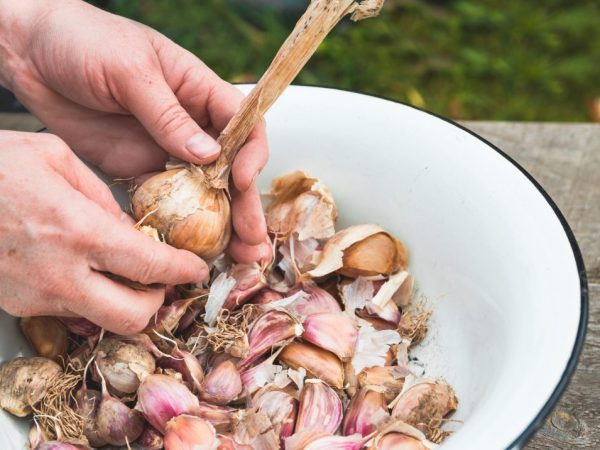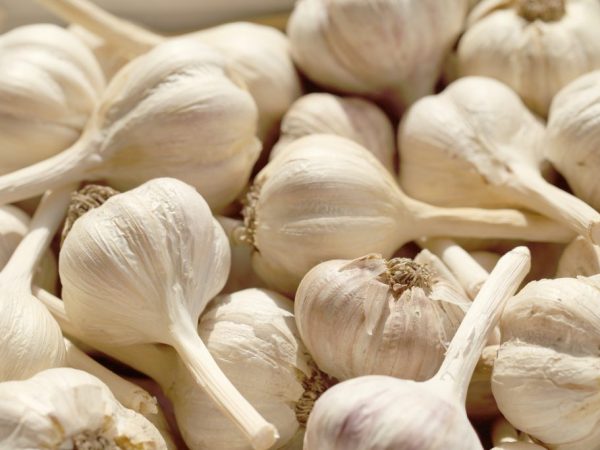Garlic processing process in spring
Processing garlic in spring is a necessary procedure, because after winter the plants require careful care and feeding. The event will help get rid of diseases and pests, as well as allow the plant to receive nutrients that are so necessary after the winter cold.

Garlic processing process in spring
Types of garlic
Depending on the season when the cloves are planted, the following types of garlic are distinguished:
- winter, which is planted in the soil in the fall - it begins to actively develop with the onset of the spring thaw;
- spring - it is planted in spring during a period when the air temperature is already steadily warm.
Regardless of what time of year you plant garlic, you must properly prepare it for planting, and then for subsequent development.
Seed selection
Before planting in the ground, you should correctly select the planting material and treat it with an antiseptic in order to avoid diseases and grow a high-quality crop.
When selecting a seed, use the same rules:
- select only whole teeth;
- check the planting material for rot and damage;
- take varieties that are resistant to diseases;
- prepare whole heads for planting, and divide into teeth immediately before sowing into the ground.
Before planting, disinfect the teeth by soaking in a solution of potassium permanganate. Various fungicides are also suitable for this case.
Top dressing of spring garlic
Spring garlic is planted in the fall, and in the spring it gives the first shoots. For a good harvest, when planting, it is fertilized with manure. In the spring, the plant begins to feed for good growth. A solution of carbomide or urea is an ideal top dressing.
The second feeding falls on a period of about 15 days. A solution of nitroammofoska is suitable: take 2 tablespoons. preparation and dilute in 9 liters of water. The last feeding is needed already when the heads of the vegetable are formed: a superphosphate solution is suitable.
Top dressing of winter garlic

Fertilize before planting
When planting garlic, it should be remembered that for the best development of the plant, a soil with neutral acidity is needed. In the spring, the overwintered plant needs nutrients more than ever, so fertilizers from phosphorus and potassium should be applied to the soil. Such procedures will significantly increase seedlings, the main thing is to fertilize in early spring.
The plant welcomes moisture especially after suffering frosts: from this it follows that watering should be regular and you should not wait for the soil to dry out. Especially it is necessary to ensure sufficient moisture during the period of intensive bulb formation.
In order for winter garlic to have a supply of nutrients for the whole winter, you should take care in advance about applying fertilizers to the soil immediately before planting. The procedure is carried out two weeks before planting, humus mixed with potassium phosphate is added. You can also use wood ash.
It should be remembered that you do not need to overuse fertilizers containing nitrogen.In view of the fact that the excessive content of this component in the soil can provoke the active growth of the green part of the plant. It is also recommended not to use manure as a dressing due to the fact that during the winter period it will not have time to overheat, but will only serve as a shelter for harmful insects.
Foliar processing
External dressing of winter garlic is to irrigate the outside of the plant and apply fertilizer through the leaves and stems. This method allows the plant to quickly absorb all the nutrients. The method is very effective when it comes to quickly fertilizing the future collection. Especially if the stalk of the garlic turns yellow.
The concentrate during irrigation is much weaker in composition than the main fertilizer. It is also important to remember that spraying is not a substitute for root flavors. Such procedures are carried out in the spring several times during the period of active plant formation. Spring processing is the most important at the stage of plant growth, with the help of it you can significantly increase the yield.
Treatment from yellowness
In early spring, you can see how the foliage of the vegetable crop turns yellow. Yellowing means plants are lacking in organic matter such as potassium and nitrogen. To increase the mineral content in the soil, you should treat the soil around the hole with fertilizers.
- To season the soil, we need granular urea, which we will add to the soil. Now you need to water the wells abundantly with water and sprinkle everything with compost in order to keep moisture in the ground longer.
- Another way to help the plant if it turns yellow is to treat the soil with liquid organic matter. For this we need: 1 tbsp. spoon of urea 10 liters of water. Water the plants with such a solution, taking into account the fact that the liquid consumption is 10 liters per square. This method of feeding is very effective because the liquid fertilizer is absorbed faster and gets to the root system.
- How else can a vegetable crop be processed for better growth? The spray method can be used. You will need to make a solution: potassium sulfate 1 spoon 1 liter of water. It is necessary to irrigate the leaves in the evening. To do this, choose warm and preferably calm weather, because you need the plant to be completely saturated with the mineral.
- Another way is feeding with wood ash, which is sprinkled under the plants. With each watering, more and more minerals enter the soil along with the water.
Onion Fly Treatment
If you notice yellowness on the leaves and stems of a plant, this may not mean at all that it needs feeding. Check the leaves thoroughly for larvae and small flies, because it is onion flies that can degrade the vegetable culture. Insect larvae gather at the base of the leaf and look like small worms.
In the fight against flies, spraying with a solution with salt, which is easy to prepare, will help. We need to dissolve 300 g of edible salt in a bucket of water, and then apply the solution on a vegetable crop: spray with a spray bottle or any other method known to you. Spraying with a solution of salt is not harmful to the plant and is not toxic to humans, so feel free to use this method in the fight against flies and their offspring.
Treatment with onion nematode
The cause of yellow wilting leaves and stems of vegetable crops is often a disease of the stem onion nematode. The disease can persist in the ground for tens of years and does not manifest itself at all. Infected plants begin to wither, turn yellow, and become dry. The fruits begin to fester: if you take an infected vegetable, there will be a pink-white bloom on its root, which is provoked by microscopic pests.
To avoid illness next year, it is recommended that subsequent seedlings be planted in a different place. At this time, there is no such remedy that would completely help in the fight against the disease of Nematode.A measure of disease prevention is the disinfection of cloves for sowing. To do this, they are soaked in a solution with salt for several hours before planting. Such a procedure will significantly reduce the number of pests on the seed.
The disease develops more in an acidic environment, so you need to treat the soil with lime or dolomite flour every spring. Also, in the fight against Nematoda, the following method will help - sow calendula or marigolds at the site of infection, which will neutralize the Nematoda with their poisonous juice.


